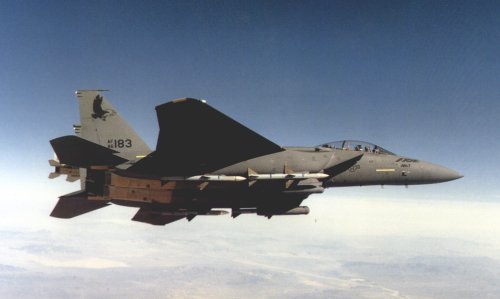All F-15s were built with air-to-ground capability, and are wired for the carriage of air-to-ground ordnance. They were originally intended as dual-role aircraft, but the ground attack role was abandoned in 1975 and the relevant software was never incorporated. Trials of an air-to-ground F-15 began during 1982, when McDonell Douglas modified the second TF-15A as the 'Strike Eagle', funding the project itself. The aircraft was conceived as an ETF (Enhanced Tactical Fighter) replacement for the General Dynamics F-111 and was chosen in preferance to the 'cranked wing' F-16XL Fighting Falcon. The 'Strike Eagle' demonstrator was joined by an F-15C and an F-15D which conducted trials with a variety of fuel and ordnance loads, usually with CFTs fitted. The resulting F-15E was given go-ahead on 24 February 1984 and the first production aircraft made its maiden flight on 11 Dec. 1986. McDonell's 'Strike Eagle' name was not adopted, though some unofficial epithets such as 'Beagle' (Bomber Eagle) and 'Mud Hen' have benn used on occasion.
 In introducing new avionics and equipment for a
'mud-moving' role not assigned to earlier variants, the F-15E is very much a
second-generation Eagle. The aircraft introduced redesigned controls, a wide field of
vision HUD, and three CRTs that provide multi-purpose displays of navigation, weapons
delivery and systems operations. The rear-cockpit WSO employs four multi-purpose CRT
terminals for radar, weapon selection and monitoring of enemy tracking systems. The WSO
also operates an AN/APG-70 synthetic aperture radar and Martin-Marietta LANTIRN
navigation (AN/AAQ-13) and targeting (AN/AAQ-14) pods. The navigation pod incorporates its
own terrain-following radar, which can be linked to the aircraft's flight control system
to allow automatic coupled terrain-following flight. The targeting pod allows the aircraft
to self-designate GBU-10 and GBU-24 laser-guided bombs. Basic flight controls are also
provided. Both pilot and WSO sin in tandem on ACES II zero-zero ejection seats.
In introducing new avionics and equipment for a
'mud-moving' role not assigned to earlier variants, the F-15E is very much a
second-generation Eagle. The aircraft introduced redesigned controls, a wide field of
vision HUD, and three CRTs that provide multi-purpose displays of navigation, weapons
delivery and systems operations. The rear-cockpit WSO employs four multi-purpose CRT
terminals for radar, weapon selection and monitoring of enemy tracking systems. The WSO
also operates an AN/APG-70 synthetic aperture radar and Martin-Marietta LANTIRN
navigation (AN/AAQ-13) and targeting (AN/AAQ-14) pods. The navigation pod incorporates its
own terrain-following radar, which can be linked to the aircraft's flight control system
to allow automatic coupled terrain-following flight. The targeting pod allows the aircraft
to self-designate GBU-10 and GBU-24 laser-guided bombs. Basic flight controls are also
provided. Both pilot and WSO sin in tandem on ACES II zero-zero ejection seats.
Power for the new variant was initially provided by F100-PW-220 turbofans, as used by the F-15C, with a digital engine control system, but this was soon replaced under the Improved Performance Engine program, whereby GE F110-GE-129 and P&W F100-PW-229 engines were both flown in F-15Es under competitive evaluation; the Pratt & Whitney engine was eventually selected. Since August 1991 (serial number 90-0233) the new engine has been fitted on the production line, and other aircraft will be retrofitted. To suit the F-15E for the rigors of the low-level role, the aircraft was structurally redesigned for a 16,000-hour life and loads of up to 9 g. More use was made of superplastic forming and diffusion bonding in the rear fuselage, engine bay and some panels. The fuel tanks have been filled with reticulated foam, reducing capacity to 2,019 US gal (7643 liters).
In 1988, the 405th Tactical Training Wing at Luke AFB, AZ, became Tactical Air Command's replacement training unit for the F-15E Eagle aircraft, a role since taken over by the 58th Fighter Wing in Air Education and Training Command. The first operational F-15Es were delivered to the 4th TFW, Seymour Johnson AFB, NC, taking the place of the F-4E Phantom.
On 12 August 1990, as the US began Operation Desert Shield, F-15E Eagles from the 336th TFS, 4th TFW, deployed to Al Kharj air base, Saudi Arabia. F-15Es of that wing's 335th TFS followed. During Desert Storm, F-15Es were assigned strike missions against a variety of targets, including five/six-hour sorties in search of 'Scud' missile launch sites. Two F-15E Eagles were lost in combat during 2,200 sorties totalling 7,700 hours.
In 1991, the Secretary of Defense overruled USAF leaders who wanted to keep the F-15E Eagle in production. Although the F-15E is an exceedingly potent warplane for the strike missions, critics point out that its low wing-laoding produces a rough ride, especially for the backseater, and that the F-15E's payload is less than that of the 30-year-old F-111. The US Air Force wanted to keep the production line open tp 'bridge' a hoped-for additional purchase from Saudi Arabia directly from inventory.
